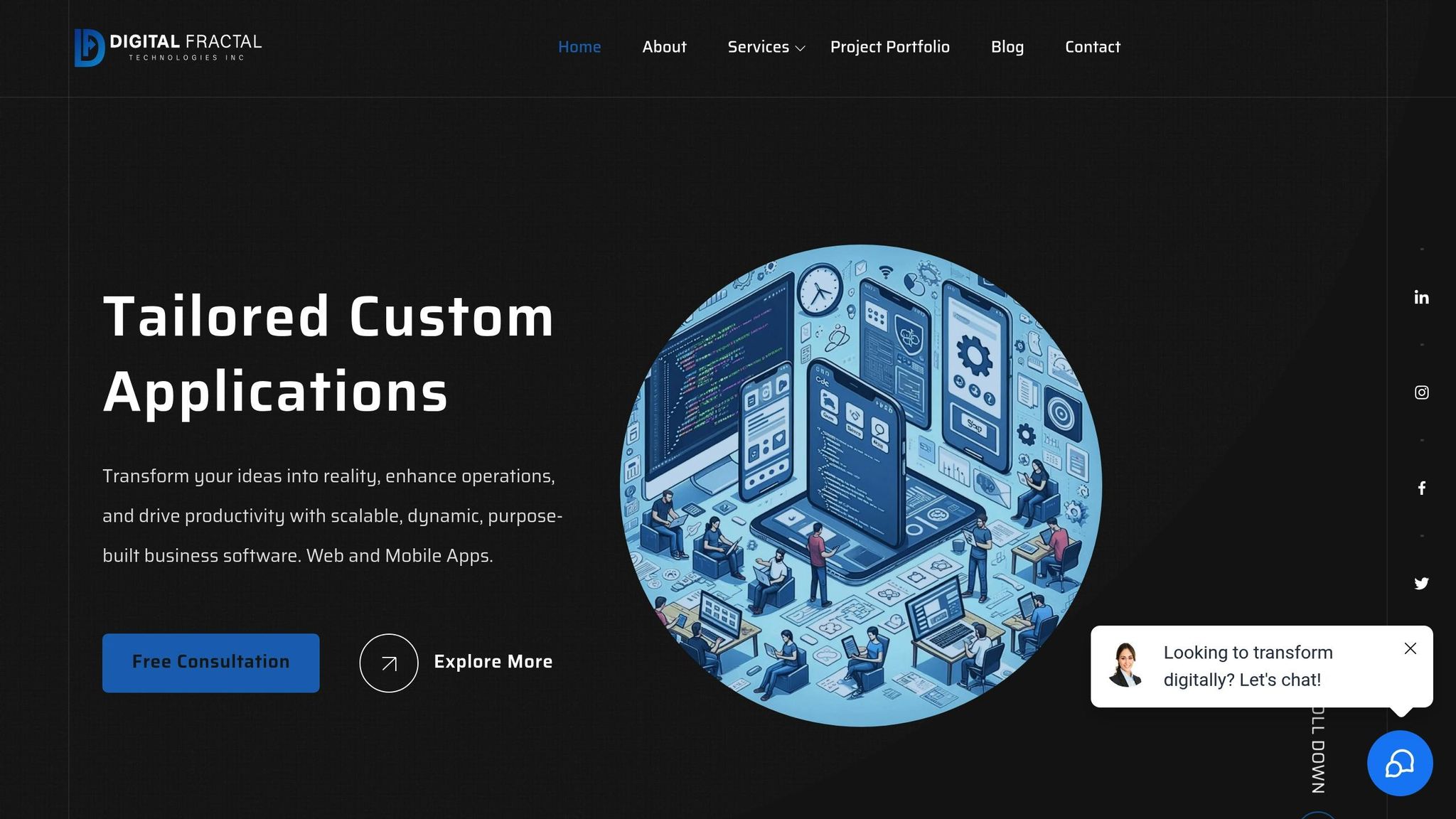
How AI Enhances Web App Security Frameworks
AI is transforming web application security by offering tools that detect, prevent, and respond to threats faster and more effectively than older methods. Canadian businesses, especially in regulated sectors like energy, government, and construction, are leveraging AI-powered frameworks to protect sensitive data, comply with regulations like PIPEDA, and boost efficiency. Key features include:
- Real-time monitoring to detect and respond to threats instantly.
- Anomaly detection using machine learning to identify unusual activity.
- Automated vulnerability scanning to uncover and prioritize security flaws.
- Incident response automation that reduces manual intervention.
AI reduces false positives, speeds up response times by up to 90%, and helps meet compliance requirements. While challenges like data quality and AI transparency exist, solutions like those offered by Digital Fractal Technologies Inc are helping Canadian organizations secure their web applications effectively.
AI Security Frameworks: Must-Know Challenges & Solutions For 2025
Core Methods: How AI Improves Web Application Security
AI strengthens web application security through three key approaches: anomaly detection, vulnerability scanning, and real-time monitoring.
Anomaly Detection and Threat Identification
AI uses machine learning to establish what "normal" activity looks like for a web application. By studying patterns such as login times, data transfer volumes, API call frequencies, and navigation behaviours, it builds a profile of typical user activity.
When unusual events occur – like repeated failed login attempts from various locations or unexpected spikes in database queries – AI flags these as potential threats. This method not only detects known attack patterns but also identifies zero-day exploits that haven’t been encountered before.
To refine its accuracy, AI employs several machine learning methods:
- Supervised learning uses past attack data to classify threats.
- Unsupervised learning detects new anomalies that don’t match prior patterns.
- Reinforcement learning continuously improves security policies based on outcomes, making the system smarter over time.
What sets this apart is AI’s ability to perform contextual analysis. Instead of flagging isolated events, it connects multiple data points – like user actions, network traffic, and historical incidents – to decide whether an anomaly is a genuine threat or harmless activity. This reduces the number of false alarms.
Anomaly detection lays the groundwork for AI’s next layer of defence: vulnerability scanning.
Vulnerability Scanning and Automated Code Analysis
AI-powered tools have transformed how developers uncover and address security flaws during development. By leveraging pattern recognition and static code analysis, these tools quickly identify vulnerabilities like SQL injection and cross-site scripting (XSS).
But detection is just the start. AI tools also rank vulnerabilities by severity and potential impact, enabling teams to focus on the most critical issues first.
For Canadian organizations, this is particularly useful in meeting local security and privacy regulations. AI-driven code analysis ensures vulnerabilities are identified and resolved promptly, helping businesses comply with frameworks like NIST and ISO 42001.
AI integrates security into every stage of development, catching issues before they make it into production environments. This proactive approach complements AI’s ability to monitor applications in real time.
Real-Time Monitoring and Incident Response
AI provides continuous oversight of live applications, analysing traffic, user behaviour, and system events in real time. This allows for immediate action against threats, often stopping malicious activity before damage can occur.
When suspicious activity is detected, AI can take direct action – blocking IP addresses, ending sessions, or restricting data access. For critical threats, the system notifies security teams while independently managing routine incidents.
IBM‘s Security AI and Data Science division reported that AI-driven systems reduced incident response times by 80% in 2022, which helped lower costs and speed up containment efforts for enterprise clients.
AI doesn’t stop at containment. It also triages alerts, prioritizes critical threats, and initiates pre-set remediation steps, reducing the workload on security teams. This ensures consistent and timely responses, minimizing downtime and limiting the impact of security breaches.
For organizations managing sensitive data – whether it’s citizen records in government systems or operational data in energy infrastructure – this rapid response capability is crucial. While fixing vulnerabilities can take over 90 days for many organizations, AI tools significantly shorten this timeline by automating vulnerability management.
Digital Fractal Technologies Inc has successfully implemented these AI-driven security solutions for clients in Canada’s public sector, energy, and construction industries. Their frameworks combine automated vulnerability detection, real-time threat monitoring, and incident response, helping organizations protect sensitive data, meet Canadian security standards, and operate more efficiently.
Key Benefits of AI-Powered Security Frameworks
AI-powered security frameworks bring a new level of sophistication to how Canadian organizations handle security, compliance, and operational challenges. By leveraging advanced detection and response methods, these frameworks go beyond basic threat detection, reshaping the way businesses safeguard their operations.
Better Threat Detection and Accuracy
AI takes threat detection to the next level by setting behavioural baselines and identifying anomalies through real-time monitoring. This makes it possible to catch advanced threats that traditional rule-based systems often overlook.
One standout advantage is AI’s ability to significantly cut down on false positives. Traditional systems tend to bombard security teams with unnecessary alerts, wasting time and resources on non-issues. AI-driven solutions can reduce false positives by as much as 90%, easing the workload for IT teams and minimizing alert fatigue.
Natural language processing (NLP) further sharpens accuracy by distinguishing actual vulnerabilities from harmless code. This contextual understanding allows security teams to zero in on genuine threats.
AI also excels at spotting zero-day exploits and previously unknown attack methods through automated code analysis and pattern recognition. By studying historical data on security incidents, user behaviour, and network traffic, AI identifies subtle patterns that could signal a potential threat before it fully materializes. This predictive capability gives Canadian organizations a proactive edge in averting attacks.
Improved Data Protection and Compliance
For Canadian businesses managing personal information, AI frameworks are a powerful ally in meeting regulatory requirements like the Personal Information Protection and Electronic Documents Act (PIPEDA). These systems automatically enforce encryption, access controls, and secure data handling practices throughout the software lifecycle.
AI also simplifies compliance by detecting sensitive training data and securing it with specialized controls, ensuring adherence to Canadian data protection standards. Additionally, AI can collect audit evidence automatically, saving compliance teams hundreds of hours. This reduces the administrative burden on IT staff and streamlines documentation for regulatory audits.
By maintaining constant visibility into data flows and security measures, AI helps organizations demonstrate compliance with PIPEDA. This is especially crucial for government agencies and regulated industries like energy and construction, where data breaches can result in significant penalties and reputational harm.
Efficiency and Cost Savings
AI’s automation capabilities bring both efficiency and financial benefits to Canadian organizations. Tasks like vulnerability detection, threat analysis, and incident response are streamlined, freeing up security teams to focus on strategic initiatives instead of routine monitoring.
For instance, AI-powered static code analysis tools can scan millions of lines of code in a fraction of the time it would take human analysts. This not only speeds up vulnerability remediation but also reduces technical debt. AI even goes a step further by generating actionable code patches for identified vulnerabilities, saving costs tied to prolonged exposure.
The financial advantages extend to incident response as well. Faster detection and response times mean reduced downtime and lower financial losses from breaches. According to IBM research, organizations using AI report quicker response times and improved operational efficiency.
For Canadian businesses, these efficiencies translate into lower operational costs and better resource allocation. IT budgets can shift from reactive spending to proactive security measures and innovation, delivering a strong return on investment for AI-driven security frameworks.
Digital Fractal Technologies Inc exemplifies these benefits through their tailored AI-driven security solutions. Their expertise in custom software development and AI consulting helps Canadian businesses enhance threat detection, streamline compliance, and boost operational efficiency – all while meeting local regulatory standards. This demonstrates the growing importance of AI in modern web application security.
sbb-itb-fd1fcab
Challenges and Considerations
AI-powered security frameworks bring undeniable benefits, but they also come with a set of challenges that organizations must navigate carefully. Addressing these issues is key to ensuring smooth implementation and maximizing the potential of these systems while minimizing risks.
Transparency and Explainability of AI Models
One of the biggest hurdles lies in the "black box" nature of many AI systems. When an AI flags a suspicious user action or blocks a transaction, it’s not always clear why. This lack of clarity can be especially problematic in regulated industries, where compliance with laws like PIPEDA requires organizations to justify decisions made by automated systems. For example, a bank using AI to detect fraud must be able to explain why a specific transaction was flagged to maintain both compliance and user trust.
Opaque decision-making doesn’t just hinder compliance – it also complicates fine-tuning and incident investigations. As regulations increasingly demand explainable AI, companies that fail to meet these requirements risk facing penalties, losing stakeholder confidence, and falling out of compliance. To address this, businesses should document AI decisions, perform regular audits, and adopt frameworks that prioritize explainability, such as the NIST AI Risk Management Framework or ISO 42001. These steps can help organizations meet regulatory standards while also building trust with users and stakeholders.
This lack of transparency also opens the door to other risks, such as adversarial attacks.
Risks of Adversarial Attacks
AI systems face unique threats, one of the most concerning being adversarial attacks. These occur when malicious actors manipulate inputs – like tweaking malware code or creating deceptive phishing emails – to fool AI models into making incorrect decisions. Even small changes in input data can exploit vulnerabilities, posing serious risks for industries like finance and healthcare, where successful attacks could lead to data breaches and heavy regulatory penalties.
To counter these threats, organizations need a multi-layered defence strategy. This includes rigorous testing against manipulated inputs, continuous monitoring of AI performance, and implementing adversarial training to make models more resilient. Additionally, many companies are now investing in tools that simulate such attacks, helping to identify and patch vulnerabilities before they can be exploited. These proactive measures are critical to maintaining the effectiveness of AI-driven security systems in the face of evolving threats.
Data Quality and Bias Concerns
The success of AI security frameworks hinges on the quality of the data they are trained on. Poor-quality data – whether incomplete, outdated, or biased – can significantly undermine an AI model’s ability to detect threats reliably. A 2024 survey revealed that 68% of Canadian businesses identified data quality as a major obstacle in deploying AI-based security solutions.
Bias in training data is another significant issue. For instance, models trained on data that overrepresent certain types of attacks may struggle to detect rarer but equally critical threats. Similarly, a model built using data from large enterprises might fail to identify risks specific to smaller businesses or niche Canadian industries. Historical data can also introduce outdated security practices, further skewing model performance.
The consequences of poor data quality and bias are severe, ranging from missed threats to compliance failures and reputational damage. To mitigate these risks, organizations should implement strong data governance practices. This includes using diverse and representative datasets, regularly auditing model outputs for fairness, and incorporating feedback from security analysts. Routine data validation and cleansing are also essential to ensure training data remains accurate and relevant. When AI models are built on high-quality, unbiased data, they can reduce incident response times by up to 60%. For Canadian businesses, prioritizing data quality and diversity isn’t just a best practice – it’s a necessity for building reliable and trustworthy security systems.
Digital Fractal Technologies Inc addresses these challenges by offering AI consulting services tailored to create secure, transparent, and compliant solutions that align with Canadian standards.
AI-Powered Security in Practice: Canadian Context
Canadian organizations are increasingly turning to AI-powered security frameworks to safeguard their web applications. This growing trend is driven by the need to align with Canada’s stringent regulatory requirements.
Alignment with Canadian Security Standards
AI-powered security frameworks in Canada operate within a highly regulated environment, with PIPEDA (Personal Information Protection and Electronic Documents Act) serving as the foundation for data protection in commercial settings. These frameworks incorporate encryption, access controls, secure data management, and automated threat detection to ensure compliance with PIPEDA.
Many organizations are also adopting the NIST AI Risk Management Framework to guide the ethical use of AI, assess risks, and maintain ongoing monitoring. This helps them adhere to both Canadian and international standards for AI security. A 2024 industry report revealed that over 60% of Canadian enterprises in regulated sectors have either implemented or piloted AI-powered security tools to improve compliance and enhance threat detection.
| Framework/Standard | Key Features for AI Security |
|---|---|
| PIPEDA | Data privacy, breach notification |
| NIST AI RMF | Risk management, transparency, explainability |
| ISO 42001 | AI lifecycle management, compliance |
One standout feature of these frameworks is audit readiness. AI frameworks automatically gather evidence for reviews, making it easier for organizations to stay compliant. Continuous monitoring helps identify and address compliance gaps quickly, while automated documentation reduces the manual effort required during audits.
Industry Use Cases by Digital Fractal Technologies Inc

Canadian industries are already seeing the benefits of AI security solutions in action. Digital Fractal Technologies Inc is a leader in deploying these solutions across sectors like energy, government, and construction.
In 2024, the company collaborated with a major Canadian energy provider to implement a workflow automation platform featuring real-time anomaly detection, automated incident response, and PIPEDA-compliant monitoring. Within six months, the energy provider achieved a 40% reduction in security incident response times and successfully passed a third-party compliance audit without significant findings.
For the public sector, Digital Fractal Technologies Inc developed custom web applications with built-in anomaly detection to ensure secure data handling and compliance with government regulations. In March 2024, a Canadian public sector agency adopted their vulnerability scanning tool, enabling weekly scans instead of the previous quarterly schedule. This shift resulted in a 70% decrease in unpatched vulnerabilities and better audit outcomes.
In the construction industry, the company introduced workflow automation tools designed to monitor user activity and flag unusual behaviour, ensuring compliance with Canadian privacy laws. These scalable solutions also include mobile apps with automated incident response capabilities tailored for field operations.
The results speak for themselves: organizations report up to 70% faster detection and resolution of vulnerabilities, along with a noticeable drop in security breaches after implementing these frameworks. For example, vulnerability scanners can process millions of lines of code in minutes, identifying risks like SQL injection and cross-site scripting far more efficiently than manual reviews.
Digital Fractal Technologies Inc designs its solutions with Canadian standards in mind, offering industry-specific security measures that meet strict regulatory demands. Their frameworks can be configured to keep sensitive data within Canadian borders, addressing data residency and sovereignty requirements. Additionally, they provide privacy controls, audit trails, and reporting features tailored to Canadian compliance needs.
The company’s focus on scalable, purpose-built applications ensures that their solutions cater to both small businesses and large enterprises across Canada. With continuous updates based on new threat intelligence, their AI models remain effective against emerging risks. These case studies highlight how AI security solutions not only protect sensitive data but also simplify compliance within Canada’s regulatory landscape.
Conclusion
AI has reshaped the way web application security frameworks operate, moving the focus from reacting to threats to actively preventing them. With advanced threat detection, real-time monitoring, automated responses, and predictive analysis, AI offers capabilities that go far beyond what traditional systems can achieve. For Canadian organisations navigating an increasingly complex threat environment, these tools are becoming essential to thrive in today’s digital economy.
Consider this: AI-powered tools can cut incident response times by up to 90% and scan codebases up to 10 times faster compared to older methods. These improvements not only safeguard digital assets but also deliver meaningful cost savings for businesses willing to embrace the technology.
For Canadian companies, there’s also the challenge of staying compliant with frameworks like PIPEDA. AI solutions simplify this by automating compliance processes and securely managing data for audits. On top of that, a reduction in false positives – by as much as 50% in some instances – helps improve productivity and reduce unnecessary expenses.
However, implementing AI-driven security isn’t without its hurdles. Issues such as the transparency of AI models, risks of adversarial attacks, and concerns about data quality need to be addressed. To overcome these, Canadian organisations must prioritize explainable AI, maintain human oversight, and ensure models are regularly updated to tackle biases and adapt to new threats. By collaborating with experienced providers like Digital Fractal Technologies Inc, businesses can navigate these challenges while meeting strict regulatory standards.
Adopting AI-powered security tools is no longer optional – it’s a necessity. With cyber threats growing more sophisticated and compliance demands becoming stricter, delaying adoption puts organisations at risk of falling behind both in security and operational efficiency. The real question isn’t whether Canadian businesses should adopt AI-driven security but how quickly they can integrate these solutions to safeguard their digital future.
FAQs
How does AI help reduce false positives in web app security, and why is this important for security teams?
AI has transformed web app security frameworks by offering a sharp edge in detecting threats. By processing massive amounts of data in real-time, it can spot patterns that separate actual dangers from harmless actions. Through machine learning, these systems stay ahead of evolving attack techniques while cutting down on false alarms – those pesky alerts caused by non-threatening activity.
Fewer false positives mean security teams can zero in on genuine threats without wasting time or resources. This also reduces the risk of "alert fatigue", where constant, unnecessary warnings might cause important ones to be missed. In high-stakes environments, where swift and accurate threat detection is non-negotiable, AI-powered security tools prove invaluable for maintaining strong defences.
How can organizations ensure AI models are transparent and explainable in regulated industries?
Organizations in regulated industries face unique challenges when it comes to ensuring transparency and clarity in their AI systems. To tackle these, several practical steps can make a big difference.
One important approach is using interpretable AI algorithms – these are designed to make the decision-making process easier to understand for stakeholders. Regular audits and validations are another crucial step. They help verify that AI models meet industry regulations and uphold ethical standards.
Another key practice is documenting the decision-making processes of AI systems in detail. This ensures that outcomes are clearly explained and easy to trace. Involving domain experts and keeping open lines of communication with regulatory bodies can further promote trust and accountability. These efforts not only help organizations meet compliance requirements but also ensure their AI systems align with their operational goals.
How can AI-driven security frameworks help Canadian businesses comply with PIPEDA and strengthen data protection?
AI-driven security systems are proving to be a game-changer for Canadian businesses aiming to comply with PIPEDA (Personal Information Protection and Electronic Documents Act). These technologies enhance the way sensitive data is monitored, safeguarded, and managed. By leveraging advanced algorithms, they can spot vulnerabilities, detect unusual activity, and respond to potential threats in real time – significantly lowering the chances of data breaches.
What’s more, AI simplifies compliance by automating routine checks and streamlining data management processes. This helps businesses stay aligned with critical privacy principles like accountability, consent, and the protection of personal information. Beyond just meeting legal obligations, these measures also foster trust among clients and stakeholders in Canada’s ever-evolving digital environment.

